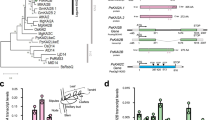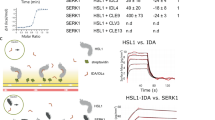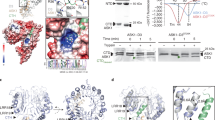Abstract
Strigolactones (SLs) regulate many aspects of plant development, but ambiguities remain about how this hormone is perceived because SL-complexed receptor structures do not exist. We find that when SL binds the Striga receptor, ShHTL5, a series of conformational changes relative to the unbound state occur, but these events are not sufficient for signalling. Ligand-complexed receptors, however, form internal tunnels that posit an explanation for how SL exits its receptor after hydrolysis.
This is a preview of subscription content, access via your institution
Access options
Access Nature and 54 other Nature Portfolio journals
Get Nature+, our best-value online-access subscription
$29.99 / 30 days
cancel any time
Subscribe to this journal
Receive 12 digital issues and online access to articles
$119.00 per year
only $9.92 per issue
Buy this article
- Purchase on Springer Link
- Instant access to full article PDF
Prices may be subject to local taxes which are calculated during checkout


Similar content being viewed by others
Data availability
All data supporting the findings of this study are available within the paper, its Extended Data and Supplementary Information. The crystallographic structure of GR24-bound ShHTL5 was deposited at the Protein Data Bank with PDB ID 8DVC. Any additional information or materials will be shared by the authors upon request.
References
Kyozuka, J., Nomura, T. & Shimamura, M. Origins and evolution of the dual functions of strigolactones as rhizosphere signaling molecules and plant hormones. Curr. Opin. Plant Biol. 65, 102154 (2022).
Aquino, B., Bradley, J. M. & Lumba, S. On the outside looking in: roles of endogenous and exogenous strigolactones. Plant J. 105, 322–334 (2021).
Bhoi, A., Yadu, B., Chandra, J. & Keshavkant, S. Contribution of strigolactone in plant physiology, hormonal interaction and abiotic stresses. Planta 254, 28 (2021).
Kelly, J. H., Tucker, M. R. & Brewer, P. B. The strigolactone pathway is a target for modifying crop shoot architecture and yield. Biology 12, 95 (2023).
Lumba, S., Subha, A. & McCourt, P. Found in translation: applying lessons from model systems to strigolactone signaling in parasitic plants. Trends Biochem. Sci. 42, 556–565 (2017).
Janssen, B. J. & Snowden, K. C. Strigolactone and karrikin signal perception: receptors, enzymes, or both? Front. Plant Sci. 3, 296 (2012).
Zhao, L. H. et al. Destabilization of strigolactone receptor DWARF14 by binding of ligand and E3-ligase signaling effector DWARF3. Cell Res. 25, 1219–1236 (2015).
Zhou, F. et al. D14-SCF(D3)-dependent degradation of D53 regulates strigolactone signalling. Nature 504, 406–410 (2013).
Yao, R. et al. DWARF14 is a non-canonical hormone receptor for strigolactone. Nature 536, 469–473 (2016).
de Saint Germain, A. et al. An histidine covalent receptor and butenolide complex mediates strigolactone perception. Nat. Chem. Biol. 12, 787–794 (2016).
Waters, M. T. et al. A Selaginella moellendorffii ortholog of KARRIKIN INSENSITIVE2 functions in Arabidopsis development but cannot mediate responses to karrikins or strigolactones. Plant Cell 27, 1925–1944 (2015).
Seto, Y. et al. Strigolactone perception and deactivation by a hydrolase receptor DWARF14. Nat. Commun. 10, 191 (2019).
Toh, S., Holbrook-Smith, D., Stokes, M. E., Tsuchiya, Y. & McCourt, P. Detection of parasitic plant suicide germination compounds using a high-throughput Arabidopsis HTL/KAI2 strigolactone perception system. Chem. Biol. 21, 988–998 (2014).
Tsuchiya, Y. et al. PARASITIC PLANTS. Probing strigolactone receptors in Striga hermonthica with fluorescence. Science 349, 864–868 (2015).
Wang, D. et al. Probing strigolactone perception mechanisms with rationally designed small-molecule agonists stimulating germination of root parasitic weeds. Nat. Commun. 13, 3987 (2022).
Tal, L. et al. A conformational switch in the SCF-D3/MAX2 ubiquitin ligase facilitates strigolactone signalling. Nat. Plants 8, 561–573 (2022).
Toh, S. et al. Structure-function analysis identifies highly sensitive strigolactone receptors in Striga. Science 350, 203–207 (2015).
Flematti, G. R., Scaffidi, A., Waters, M. T. & Smith, S. M. Stereospecificity in strigolactone biosynthesis and perception. Planta 243, 1361–1373 (2016).
Jumper, J. et al. Highly accurate protein structure prediction with AlphaFold. Nature 596, 583–589 (2021).
Bunsick, M. et al. SMAX1-dependent seed germination bypasses GA signalling in Arabidopsis and Striga. Nat. Plants 6, 646–652 (2020).
Wang, Y. et al. Molecular basis for high ligand sensitivity and selectivity of strigolactone receptors in Striga. Plant Physiol. 185, 1411–1428 (2021).
Arellano-Saab, A. et al. Three mutations repurpose a plant karrikin receptor to a strigolactone receptor. Proc. Natl Acad. Sci. USA 118, e2103175118 (2021).
Bzówka, M. et al. Evolution of tunnels in α/β-hydrolase fold proteins—what can we learn from studying epoxide hydrolases? PLoS Comput. Biol. 18, e1010119 (2022).
Klvana, M. et al. Pathways and mechanisms for product release in the engineered haloalkane dehalogenases explored using classical and random acceleration molecular dynamics simulations. J. Mol. Biol. 392, 1339–1356 (2009).
Nakamura, H. et al. Triazole ureas covalently bind to strigolactone receptor and antagonize strigolactone responses. Mol. Plant 12, 44–58 (2019).
Shimada, A. et al. Structural basis for gibberellin recognition by its receptor GID1. Nature 456, 520–523 (2008).
Murase, K., Hirano, Y., Sun, T. P. & Hakoshima, T. Gibberellin-induced DELLA recognition by the gibberellin receptor GID1. Nature 456, 459–463 (2008).
Minor, W., Cymborowski, M., Otwinowski, Z. & Chruszcz, M. HKL -3000: the integration of data reduction and structure solution – from diffraction images to an initial model in minutes. Acta Crystallogr. D 62, 859–866 (2006).
Afonine, P. V. et al. Towards automated crystallographic structure refinement with phenix.refine. Acta Crystallogr. D 68, 352–367 (2012).
Emsley, P., Lohkamp, B., Scott, W. G. & Cowtan, K. Features and development of Coot. Acta Crystallogr. D 66, 486–501 (2010).
Abraham, M. J. et al. GROMACS: high performance molecular simulations through multi-level parallelism from laptops to supercomputers. SoftwareX 1–2, 19–25 (2015).
Huang, J. et al. CHARMM36m: an improved force field for folded and intrinsically disordered proteins. Nat. Methods 14, 71–73 (2017).
Hanwell, M. D. et al. Avogadro: an advanced semantic chemical editor, visualization, and analysis platform. J. Cheminformatics 4, 17 (2012).
Pravda, L. et al. MOLEonline: a web-based tool for analyzing channels, tunnels and pores. Nucleic Acids Res. 46, 368–373 (2018).
Acknowledgements
A.A.-S. was partially funded by the Mexican National Council of Science and Technology (CONACyT) and by a Mitacs Globalink Graduate Scholarship. This work was supported by a Natural Sciences and Engineering Research Council of Canada (NSERC) Discovery Grant (no. 06752), an NSERC Accelerator Supplement (no. 507992), an NSERC Research Tools and Instruments grant (no. 00356), a New Frontiers in Research Fund (NFRFE-2018-00118) awarded to S.L. as well as an NSERC Discovery Grant (no. 04298) awarded to P.M. Research was also supported by Compute Ontario (https://computeontario.ca/) and Compute Canada (www.computecanada.ca). We thank R. DiLeo, O. Onopriyenko, M. Venkatesan, M. Bunsick and J. Bradley for support and technical advice.
Author information
Authors and Affiliations
Contributions
A.A.-S., P.J.S. and P.M. conceptualized the research. A.A.-S., T.S. and Z.X. performed experiments. C.S.P.M., A.S. and P.J.S. contributed new reagents and/or analysis tools. A.A.-S., A.S., S.L., P.J.S. and P.M. analysed and/or discussed data with input from all authors. A.A.-S., P.M. and P.J.S. prepared the manuscript. All authors reviewed and agreed on the manuscript.
Corresponding authors
Ethics declarations
Competing interests
The authors declare no competing interests.
Peer review
Peer review information
Nature Plants thanks Marek Marzec, Tadao Asami and the other, anonymous, reviewer(s) for their contribution to the peer review of this work.
Additional information
Publisher’s note Springer Nature remains neutral with regard to jurisdictional claims in published maps and institutional affiliations.
Extended data
Extended Data Fig. 1 Control pairwise structure alignments of ShHTL5 and ShHTL5S95A.
Control pairwise structure alignments performed on A. apo ShHTL5 (white) and an AlphaFold2 model of itself (blue) and B. ShHTL5S95A (purple) against an AlphaFold2 model of itself (blue). Magnified views show the high agreement between the catalytic triads of crystal structures and models. Both alignments show global RMSD values below 0.20 Å.
Extended Data Fig. 2 Structural models of the GID1 GA receptor and its transport tunnels.
Internal transport tunnels (red) change in shape, size, and orientation in response to gibberellic acid (GA) binding and the presence of its binding partner DELLA.
Supplementary information
Supplementary Information
PDB validation report for the crystallographic structure of ShHTL5-GR24.
Supplementary Video 1
Structural changes of ShHTL5 in response to +GR24 binding. The perception and binding mechanisms of an SL by ShHTL5 are shown, using apo ShHTL5 (PDB 5CBK) as a reference. The perception occurs in 3 phases: first, Phe134, Tyr157 and Lys218 move to accommodate GR24. Second, a group of residues located on the left lid domain change the conformation of their rotamers, creating more space in the binding pocket. Finally, the flexibility loop changes its position to bind to the downstream partner MAX2.
Supplementary Video 2
Molecular dynamics simulation displays an exit cavity forming upon GR24 binding. This movie shows the 1 µs molecular dynamics simulations of apo ShHTL5 and +GR24-bound ShHTL5. The exit end of the SL-enlarged tunnel can be observed only on the bound structure, depicted with an orange circle. MD movies represent one of three trajectories (n = 3) analysed.
Supplementary Video 3
MD simulation of the transport of SL hydrolysis product through internal tunnel of ShHTL5. This movie shows a 1 µs MD simulation of an SL hydrolysis product (PDB 4IHA) moving through the ShHTL5 transport tunnel. It can be observed how the topological landscape of the tunnel changes in response to the product approaching certain areas (that is, bottlenecks). Once the SL is positioned close to the end of the tunnel, the exit cavity is enlarged, possibly to facilitate its expulsion.
Rights and permissions
Springer Nature or its licensor (e.g. a society or other partner) holds exclusive rights to this article under a publishing agreement with the author(s) or other rightsholder(s); author self-archiving of the accepted manuscript version of this article is solely governed by the terms of such publishing agreement and applicable law.
About this article
Cite this article
Arellano-Saab, A., Skarina, T., Xu, Z. et al. Structural analysis of a hormone-bound Striga strigolactone receptor. Nat. Plants 9, 883–888 (2023). https://doi.org/10.1038/s41477-023-01423-y
Received:
Accepted:
Published:
Issue Date:
DOI: https://doi.org/10.1038/s41477-023-01423-y



